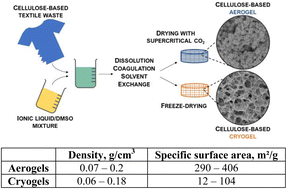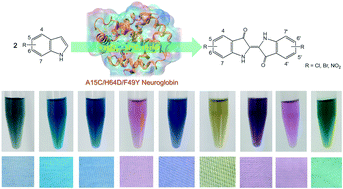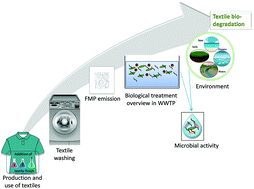Themed collection Sustainable fashion

Charting a path to catalytic upcycling of plastic micro/nano fiber pollution from textiles to produce carbon nanomaterials and turquoise hydrogen
This article demonstrates proof-of-concept for upcycling textile derived microfibers to structured solid carbon products of value using a representative well defined feedstock of real textile derived fibers of polyester and cotton.

RSC Sustainability, 2023,1, 1177-1183
https://doi.org/10.1039/D3SU00095H
Microbial nanocellulose biotextiles for a circular materials economy
Harnessing microbial biofabrication coupled to a protocol inspired by indigenous textile processes, we engineer high-performance biotextiles with a sustainable circular life cycle, including the plant and mineral dyed bioleather sneakers shown.

Environ. Sci.: Adv., 2022,1, 276-284
https://doi.org/10.1039/D2VA00050D
Valorisation of sulphonated lignin as a dye for the sustainable colouration of wool fabric using sustainable mordanting agents: enhanced colour yield, colourfastness, and functional properties
Wool fabric was coloured using sulphonated lignin as a natural dye and a range of sustainable mordanting agents that considerably improved colourfastness to washing and introduced new functional properties.

RSC Sustainability, 2024,2, 676-685
https://doi.org/10.1039/D3SU00402C
Adsorption efficiency of crystal violet from the aqueous phase onto a carbonaceous material prepared from waste cotton and polyester
This research aims to evaluate waste cotton and polyester as effective potential adsorbents for the removal of crystal violet (CV) from aqueous phases.

RSC Sustainability, 2024,2, 179-186
https://doi.org/10.1039/D3SU00342F
Recovery of palladium from waste fashion items through food waste by-products
We propose an affordable and safe route to recover palladium in its metallic form from waste fashion items and recycle it in electronic devices.

RSC Sustainability, 2023,1, 2350-2357
https://doi.org/10.1039/D3SU00242J
Influence of DP and MMD of the pulps used in the Ioncell® process on processability and fiber properties
The Ioncell process is capable of producing high-quality regenerated cellulose fibers from dissolving pulps with a wide range of intrinsic viscosity and different molecular mass distributions.

RSC Sustainability, 2023,1, 1497-1510
https://doi.org/10.1039/D3SU00013C
Upcycling of textile waste into high added value cellulose porous materials, aerogels and cryogels
Aerogels and cryogels were obtained from cellulose-based textile waste.

RSC Sustainability, 2023,1, 335-345
https://doi.org/10.1039/D2SU00084A
From waste to wearable: an alternative waste stream for unusable textiles turned into piezoelectric textiles
A new recyclability path for unusable textiles are processed into electronic textiles. These materials can be implemented into such applications as energy harvesting or sensing devices that can be worn as demonstrated by our smart mask.

RSC Sustainability, 2023,1, 326-334
https://doi.org/10.1039/D2SU00068G
Establishing an energy-saving scouring/bleaching one-step process for cotton/spandex fabric using UVA-assisted irradiation
To reduce the energy and water consumption from a conventional textile industry, a facile and efficient UVA-assisted scouring/bleaching strategy has been customized for cotton/spandex in this research.

RSC Adv., 2022,12, 9404-9415
https://doi.org/10.1039/D2RA00659F
Design and engineering of neuroglobin to catalyze the synthesis of indigo and derivatives for textile dyeing
Human neuroglobin (Ngb) was rationally engineered into an enzyme by triple mutations, A15C/H64D/F49Y Ngb, which efficiently catalyzes the synthesis of indigo and derivatives with different colors for textile dyeing.

Mol. Syst. Des. Eng., 2022,7, 239-247
https://doi.org/10.1039/D1ME00123J
Synthesis and melt-spinning of partly bio-based thermoplastic poly(cycloacetal-urethane)s toward sustainable textiles
Partly bio-based thermoplastic poly(cycloacetal-urethane)s synthesized and melt-spun into textile fibres that can be potentially chemically recycled.

Polym. Chem., 2021,12, 4942-4953
https://doi.org/10.1039/D1PY00450F
The influence of textile finishing agents on the biodegradability of shed fibres
Biodegradation of shed fibres originated from textile washing.

Green Chem., 2021,23, 5212-5221
https://doi.org/10.1039/D1GC00883H
Towards circular fashion – transforming pulp mills into hubs for textile recycling
Textile recycling can be integrated in pulp mills through the use of green liquor in the pretreatment of the textiles.

RSC Adv., 2021,11, 12321-12329
https://doi.org/10.1039/D1RA00168J
About this collection
The impact of fast fashion on the planet is costly; PVCs used in the manufacturing process are harmful for the environment, particularly for waterways and wildlife. Chemists are tackling this challenge by creating sustainable alternatives for the fashion industry and beyond.
This collection of research showcases some of the innovative approaches to making fashion more sustainable, from waste to wearables, textile upcycling and recycling and more.